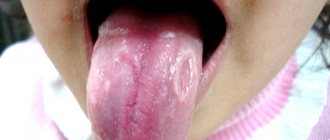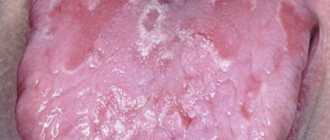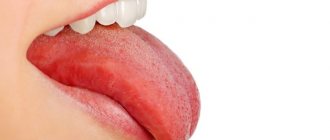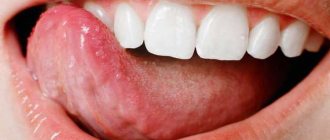What is geographic language
Geographic tongue (desquamative glossitis) is an inflammatory disease of the mucous membrane of the tongue, which is normally covered with small papillae (hairs). With the development of pathology, the latter become deformed, the surface becomes smooth and red. In appearance, the lesions resemble a geographical map with islands.
Inflammatory foci have elevated, clearly defined boundaries. They differ in their ability to heal in one place and move to another. More often there is an alternation of compactions with sagging mucous membranes.
Before prescribing treatment for a disease, it is necessary to accurately determine the causes that led to the pathology and, if possible, eliminate them, since this problem is not only cosmetic in nature, but can also lead to serious consequences.
Signs of a serrated tongue
When your tongue has a wavy edge, it is usually enlarged or swollen, with "dental impressions - depressions on the sides" [tandurust.com]. The tongue may retain its natural color, but some redness may occur if the edges experience pressure or friction from contact with the teeth. In addition, there may be other symptoms associated with the cause of the scalloped tongue: sore throat, swollen and painful tongue, halitosis (bad breath), etc.
Serrated tongue
Causes
Today, the disease is quite common, but despite this, it has not been fully studied, especially the etiology. It was possible to identify a number of reasons that contribute to its development:
- Diseases of the digestive system.
- Pathologies of the thyroid gland.
- Liver diseases.
- Disorders in the circulatory system.
- Malignant and benign tumors.
- Autonomic-endocrine disorders.
- Infectious processes.
- Autoimmune diseases.
- ARVI, ARZ.
- Pathologies of the nervous system.
- Allergic diathesis.
- Pathologies occurring in the oral cavity.
- Hereditary genetics.
- Avitaminosis.
- Chronic skin diseases.
- Stressful situations.
- Diabetes.
- Long-term therapy with antibiotic drugs.
In childhood, desquamative glossitis can manifest itself against the background of general diseases of the liver, kidneys, pancreas, spleen, and desquamative glossitis. In girls, it is more often observed before the first menstruation or during bleeding.
The disease can occur either independently or as a symptom of a concomitant disease. Therefore, it is divided into primary and secondary desquamative glossitis.
Primary glossitis most often occurs when the tongue is injured by sharp edges of teeth or dentures, as well as from chemical or thermal burns. In young children, geographic tongue is diagnosed during teething.
The development of the secondary form occurs as a result of pathological reactions in the human body. This is observed due to increased sensitivity to changes in the mucous epithelium of the tongue. Such changes are promoted by chronic diseases of the liver, gall bladder, severe vitamin deficiency and others. The pathology often begins with colds, scarlet fever, measles, and typhoid fever.
What language should be normal?
A child who is completely healthy has a uniform pink tongue, without areas of inflammation. There should also be no plaque on the mucous membrane normally. Parents should be alert to the following changes in the tongue:
- Limited areas of inflammation;
- Neoplasms of various types;
- Uneven plaque, which consists of tiny particles of food and dead epithelium;
- Excessive growth of the epithelium in certain areas of the uvula.
You should pay attention to the localization of spots and areas of inflammation. This also has important diagnostic significance, since each part of the tongue is associated with the work of a specific organ.
- Liver and gallbladder – spots and plaque on the sides of the tongue;
- Intestines - changes affect the base of the uvula;
- Buds - spots located between the root and the middle of the tongue;
- Lungs - there are spots on the front of the tongue;
- The heart is connected to the tip of the organ.
Most often, spots on the tongue are caused by problems with the digestive tract. Such changes are not necessarily a sign of serious illness, but it is worth consulting your doctor about this.
Symptoms
Geographical language is manifested by the following features:
- Cloudiness of the mucous membrane - during the initial development, a whitish coating with a gray tint appears. The lesion is small - no more than three millimeters.
- Detachment of the papillae - with further development, the papillae desquamate, and underneath there is an area of bright red color, which stands out strongly against the general background of the tongue. Such an “island” can grow and move, but the boundaries remain clear.
When the focus becomes as large as possible, the boundaries are not so clearly defined and begin to blur. In the center of the lesion, the mucous membrane takes on a normal state, and along the borders keratinization and peeling (desquamation) are observed. Since the affected areas are capable of displacement, desquamation is layered one on one.
That is, new lesions appear on old lesions, the mucous membrane becomes similar to a geographical map. This process is characterized by the fact that all areas of the tongue are affected, excluding the lower part. And this picture can change daily.
Desquamative glossitis manifests itself without pronounced symptoms, so many people learn about the disease only when examined by a doctor. Occasionally, patients complain of itching and burning, discomfort while eating, and impaired sensitivity to the taste of food.
All about the symptoms and treatment of glossitis
The main symptom of the disease is the appearance of the tongue. Some patients, as a result of the disease, develop a pathological fear for their life, a panicky fear of the appearance of a malignant tumor (cancerophobia).
The development of pathology is influenced by severe stress, and it does not matter what emotions a person experiences: positive or negative. In approximately half of the cases, a parallel course with the folded tongue is observed.
Despite the fact that the pathology does not bring much discomfort, the patient is frightened by the very sight of the affected organ, which is stressful and accordingly worsens the course of the disease.
A feature of desquamative glossitis is its complete disappearance, more often for a long time, but then the symptoms reappear.
Diagnostics
Making a correct diagnosis is not particularly difficult, so any doctor can recognize the geographic language based on the following studies:
- Collection of anamnesis, which is based on the patient’s complaints and examination data.
- General analysis .
- Bacteriological culture to detect pathogenic microorganisms and determine the causative agent of the disease.
- Polymerase chain reaction (determination of the pathogen by DNA).
- Enzyme immunoassay (presence of non-standard antibodies).
- Scraping the mucous membrane of the tongue to identify treponema pallidum (if syphilis is suspected).
- analysis to detect worms.
To differentiate from other diseases, the doctor focuses more on the movement of lesions.
Treatment
Treatment is primarily aimed at eliminating the cause (problems with the gastrointestinal tract, bad habits, endocrine disorders in the body).
- Sanitation of the oral cavity – treatment of carious teeth, maintenance of oral hygiene.
- Diet – the patient is prescribed a special diet that does not contain foods and drinks that irritate the oral mucosa. For example, hot, spicy and smoked dishes, carbonated and alcoholic drinks and others.
- Quitting tobacco products.
- Local treatment involves the use of antiseptic rinsing solutions. The most commonly prescribed drugs are Chlorhexidine, Miramistin, Furacilin, and potassium permanganate.
- Novocaine blockades - injections into the area of the lingual nerve (10 injections per course).
- Solutions with an analgesic effect - in the presence of ulcers and erosions. Treated with an antiseptic solution using a tampon.
- Preparations to boost immunity: vitamin complexes, immunostimulants, antihistamines.
- Ointments – have a healing and analgesic effect, applied in the form of applications. The specialist often prescribes Actovegin, Kamistad, Lidocaine.
- Antibiotics - when purulent processes are detected in the oral cavity, regional lymph nodes and tissues: Tetracycline, Doxycycline, Rocephin, Suprax and others. In the most advanced situations, surgical intervention is prescribed.
- Mycotic drugs when fungal microorganisms are detected: Lamisil, Nystatin, Exifin.
Some patients with cancerophobia need psychological help; this requires consultation with a psychologist or psychotherapist.
Complications
The development of desquamative glossitis should not be ignored, and if detected, you should seek the help of a specialist. Many patients, having discovered a similar pathology in themselves, mistakenly take it for a cancerous tumor, although in fact the geographical language has nothing in common with it.
This benign disease does not have a tendency to become malignant; it is treated by a dentist and a gastroenterologist; in serious cases, an examination by a hematologist, gastroenterologist and endocrinologist is required.
If therapeutic measures to eliminate the geographic tongue are not carried out in a timely manner, the disease takes on a more advanced form with relapses and will be more difficult to treat. In addition, there is a risk of swelling of the tongue, which adversely affects breathing; chewing and swallowing functions are also affected. Next, the process involves regional tissues and organs.
By the way
It's sweeter to be a girl! Our perception of the taste of food depends not only on the state of the tongue, but also on many other factors, including the gender and age of the person. This is exactly the conclusion that Danish scientists came to. Experts conducted a large study involving almost 9,000 schoolchildren. All children received a set of samples of different foods, with the help of which experts had to find out how well boys and girls distinguished tastes of different intensities. It turned out that girls are better at distinguishing one or another taste than boys. Thus, the sensitivity threshold of boys to sour is 10%, and to sweet – 20% lower than that of girls. An important factor in the perception of taste is also the age of a person. Children's taste buds work better than adults'.
Prevention
To prevent the development of such a disease, you need to follow some simple preventive rules:
- Promptly treat all diseases that provoke the development of pathology.
- Do not abuse alcoholic beverages, tobacco products, sweet foods and sugar, and strong coffee.
- Take enough vitamins to avoid vitamin deficiency.
- Perform hygiene .
- Treat caries in a timely manner.
There are separate preventive measures for children:
Caring for baby teeth – timely treatment and removal of baby teeth. If a child complains of dry mouth, rinse with herbs such as sage, St. John's wort or chamomile.
Brushing your teeth should be done only with toothpastes, since the powders contain mint oil and menthol, which are bad for the oral mucosa in children.
Hairy black tongue
Such inflammation of the tongue, as in the photo, is a consequence of the proliferation and keratinization of the papillae. The main provocateurs for the development of the disease are mechanical and chemical damage, long-term use of antibiotics, and untreated oral candidiasis. The patient with this pathology does not experience the most pleasant sensations. Firstly, filiform papillae on the mucosa can grow up to 1-2 cm in height. Secondly, the affected areas become black, which looks aesthetically unattractive and forces you to always keep your mouth shut. Plus, physical discomfort also manifests itself: most often, patients complain of vomiting and a sore throat.
The photo shows hairy black glossitis









